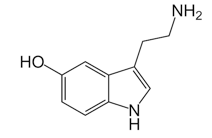Serotonin
Serotonin is formed from tryptophan in the mitochondria of chromaffin cells during the oxidative decarboxylation of 5-hydroxytryptophan. This reaction is catalyzed by L-aromatic amino acid decarboxylase.
Serotonin is found in the cells of the lungs, gastrointestinal tract, blood platelets, heparinocytes, adrenal glands, and central nervous system serotoninergic neurons concentrated in the brainstem nuclei, and enterochromaffin cells.
 Serotonin
Serotonin
Serotonin exhibits strong biological activity. It constricts blood vessels and regulates arterial blood pressure, activates intestinal peristalsis, increases capillary permeability during inflammation, helps regulate body temperature, respiration, and kidney filtration function (acts as an antidiuretic). Serotonin also acts as a mediator of nerve processes in the central nervous system. In cases of depression, the level of serotonin in the brain decreases. It is one of the most important neurotransmitters. Methylated derivatives of serotonin, such as bufotenin, act as psychogens, causing disturbances in the central nervous system activity. Bufotenin is a competitive MAO inhibitor. Competitive MAO inhibitors are hallucinogens, i.e. various narcotic substances.
Some authors claim that serotonin plays an important role in allergic processes, pregnancy toxemia, carcinoid syndrome, and the development of hemorrhagic diatheses.
MAO-A isoenzyme deaminates serotonin only by oxidative deamination.
Source | Glossary of Most Commonly Used Biomedical Terms and Concepts | Lithuanian University of Health Sciences | Academician Professor Antanas Praškevičius, Professor Laima Ivanovienė
